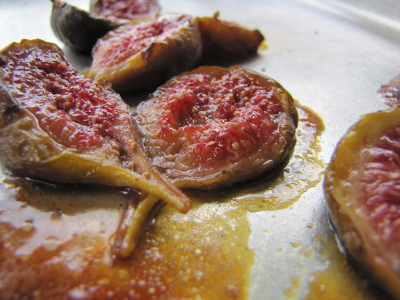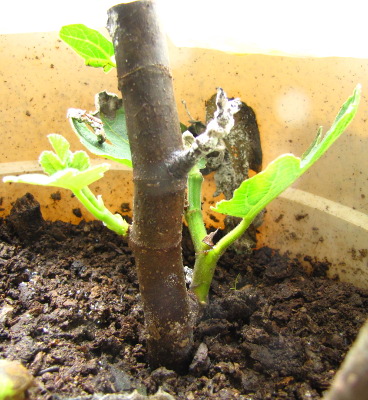
Fig propagation
 Last
week, I wrote that our first
homegrown fig was good, but not sensational. Roasting the next
four figs instead of eating them raw definitely popped them up into the
delectable category, though, which started me thinking (again) about
fig propagation.
Last
week, I wrote that our first
homegrown fig was good, but not sensational. Roasting the next
four figs instead of eating them raw definitely popped them up into the
delectable category, though, which started me thinking (again) about
fig propagation.
In our climate, a fig
"tree" is never going to be much more than a bush. Any branches I
don't protect
over the winter die
back, so the best case scenario is that our fig will expand upwards
from three foot tall trunks each spring. Since figs set fruit a
few at a time over a long season, that means our little fig bush will
be giving us four figs here and six figs there for a month or two,
which is clearly not going to be enough now that Mark and I have tasted
these homegrown fruits in their full glory.
 The
good news is that figs have turned out to be the most disease- and
insect-resistant fruits (tied with strawberries and brambles) in our
garden, so installing more won't require much effort after the initial
planting. In fact, I'd read that figs are relatively easy to
propagate from cuttings, so I half-heartedly tried a few hardwood
cuttings this spring. (If I'd known what the roasted fruits
tasted like, I would have put in a bit more effort.) While
pruning, I snipped off a few young branches and inserted them into a
pot, covering the top with a bag to hold in moisture. The
cuttings leafed out, but I think I removed the bag too soon because the
greenery ended up dying back and the figs petering out.
The
good news is that figs have turned out to be the most disease- and
insect-resistant fruits (tied with strawberries and brambles) in our
garden, so installing more won't require much effort after the initial
planting. In fact, I'd read that figs are relatively easy to
propagate from cuttings, so I half-heartedly tried a few hardwood
cuttings this spring. (If I'd known what the roasted fruits
tasted like, I would have put in a bit more effort.) While
pruning, I snipped off a few young branches and inserted them into a
pot, covering the top with a bag to hold in moisture. The
cuttings leafed out, but I think I removed the bag too soon because the
greenery ended up dying back and the figs petering out.
I'm curious to hear from
those of you who have successfully propagated figs. Did you use
hardwood or softwood cuttings? In the garden or in pots?
During what time of year? There's a plenitude of information
about fig propagation on the internet, but as usual, I'm looking for
the lowest tech solution possible, even if the success rate is only 20%
--- we've got plenty of scionwood to play with, but limited time during
the growing season.
Want more in-depth information? Browse through our books.
Or explore more posts by date or by subject.
About us: Anna Hess and Mark Hamilton spent over a decade living self-sufficiently in the mountains of Virginia before moving north to start over from scratch in the foothills of Ohio. They've experimented with permaculture, no-till gardening, trailersteading, home-based microbusinesses and much more, writing about their adventures in both blogs and books.
Want to be notified when new comments are posted on this page? Click on the RSS button after you add a comment to subscribe to the comment feed, or simply check the box beside "email replies to me" while writing your comment.

Why not put the fig brush in a big pot and let it overwinter inside, like you do with the lemons?
Anna, my question for you is what kinds of fruits and vegetables would be suited for growing inside or on a balcony that only has a couple of hours of sunshine in the evening?
Roland --- Some people do take fig plants inside for the winter, but we just don't have space for more than our current citrus, unfortunately. I'm not sure how well figs do as houseplants, though --- a friend of mine has been treating a fig tree for a few years like that and hasn't gotten any fruit, as I recall. (That could be the variety, though.)
I usually recommend herbs if you've only got a little bit of space and low light. Depending on what you like to eat, you might try thyme, basil, rosemary, etc. Even though yields aren't extremely high, you can get a bit of fresh food to spice up meals on a regular basis.
The trouble with expanding to fruits or vegetables is that you're likely to get disappointed by how little food you can get out of one pot. But if you do want to try that route, I recommend leaf crops since they handle low light better. So, leaf lettuce (rather than head lettuce), kale, etc. might be a good place to start.
We do love our dwarf Meyer lemon, and that variety is probably the best suited of the fruit plants to be raised inside. It needs a very sunny window, though.
I'll be very curious to hear what you decide to try. I hope you take pictures to share!!
We have a really low tech method of starting seedlings in our house. It's been successful so far with rhubarb, comfrey, and even apple seedlings, so I thought I might mention it: Take a used water bottle and put some potting soil, water, and a seed in the bottom, then cap the bottle and put it in a window. You might be able to do this with a 2 litre bottle and a cutting, I just haven't tried it. The bottle then acts like a greenhouse and off you go. When the plant starts hitting the sides of the bottle, turn it. When that doesn't work any more, cut the bottle in half and start watering a little bit each day.
Did I mention we also tried this with oregano, thyme, and basil? Our results weren't stellar there, but it did work. We have yet to be successful with this method with dill or lavendar, but I think we'll try it again.
We were doing really well with this method then until my less than one year old decided to pull bottles from the window sill and shake them like rattles. While amusing, I probably wasn't quite as amused as she was. I've now taken two strips of scrap plywood, placed scrap 2x4's between them for spacing, and cut holes in the top strip to hold bottles in place. These strips now hold the bottles in the window and make it harder for my (now toddler) to play shake and bake with them.
I look forward to hearing how well your efforts, however you try them, turn out.
We have a couple potted supposed "dwarf" fig trees. I had to cut them to fit them into the green house last fall (we only put them in there after it drops to about freezing so the roots and pots don't get damaged.) I just took those cuttings and cut them to 6" pieces (3-4 nodes) and put them in the dirt in the pot to see how easy it was to propagate. About 50% rooted up with no additional care. We did water regularly in the spring to keep the plant moist when it broke dormancy. I'd say they are about as easy as grapes to propagate just plant them really deep so just one node is above the soil line.
Our Issai Hardy Kiwi cuttings have grown well (3 rooted and survived being transplanted) and I was going to send you at least one if you still wanted it this fall. If you wanted any additional cuttings from figs I can get some from a Black Mission, Celeste, and our "dwarf" fig tree just let me know.
We may have some other scionwood from our other fruit trees too if there is anything in particular you may be looking for.
Fresh figs are unfortunately, pretty disappointing. I grow 10 or so varieties, and none are that tasty. That is until I dry them! Its pure heaven, the flavors that they each develop. I have one little noname fig that gets little penny sized fruits that taste like chocolate when dried.
I do propagate my figs.
Its worth noting, that not all of the varieties root aswell as others. Some have taken up to 6 months for me. I start with this years wood, that was put out as the first growth of the year. Its browned over, leafless, but is still pretty flexible. I cut it to 6 inches or so. I put it into moist soil, with only 2 buds/nodes above the surface. Its gos into a nice shady spot. Too much sun will kill them in a second.
They sit there until I can flip them out of the pot and see healthy roots. It takes around 3 months for most of my varieties to fully root out. You need to be careful though, because they can start growing like crazy but have absolutely no roots. Keeping them shaded is very important. Figs like to have cool roots.
Brian --- How exciting! I'd love to give your Issai Hardy Kiwi, Black Mission, and Celeste a try. (Probably not the dwarf fig since it sounds like it would have to come inside.) Thank you!
I think you may be my favorite reader. I'll have to work harder on making some rooted cuttings for you in exchange. Anything you see bouncing around on our blog that you'd like? Fancy kale seeds? Egyptian onions? Chicken waterers? Signed book copies? Chicago Hardy fig cuttings?
I'll have to work harder on making some rooted cuttings for you in exchange. Anything you see bouncing around on our blog that you'd like? Fancy kale seeds? Egyptian onions? Chicken waterers? Signed book copies? Chicago Hardy fig cuttings?
T --- Glad to hear you say that about fresh figs vs. dried figs. I guess we just won't eat them fresh!
I like your method of simply rooting the cuttings in the shade. Where I always go wrong is taking the bag off too soon and the sun shriveling my cuttings up, so that should fix my mistake. I'll have to treat some like grapes this winter and see if I can do better. I never had trouble with grapes, but I didn't cover them --- just stuck them in the ground in part of the garden that gets hit by the sprinkler and has partial shade and waited until the fall to see who rooted.
I think that the shade solution might be the best. Several people I know have had figs pop up from seemingly discarded cuttings, and the same thing is talked about in this really interesting article that was in the NYT yesterday
http://www.nytimes.com/2012/08/29/dining/in-brooklyn-an-abundance-of-fig-trees.html?pagewanted=all